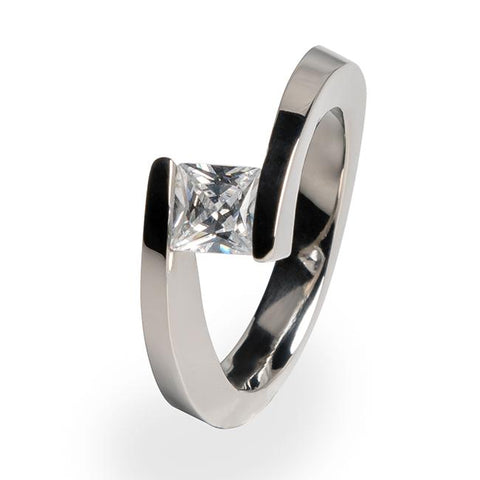100% Manufactured in North America with U.S. Aircraft Grade Titanium
The original titanium workshop since 1997 | Lifetime warranty
Diamonds are no longer a necessity when it comes to engagement rings. Today’s buyers are increasingly opting for rings with other gemstones for a variety of reasons, ranging from style and taste through to cost and ethics.
Diamonds are still immensely popular, however. And for good reason.
The beautiful and fiery gemstones have an undeniable link to love.
In this post, we’ll outline why diamonds remain a popular choice – and why we think they will well into the future.
What are natural diamonds?
Natural diamonds are diamonds that are formed in and mined from nature.
Canadian diamonds
Canadian diamonds are diamonds that are mined in Canada – the 3rd largest diamond producing country. These diamonds are known for the high-quality of the stones, for being conflict free, and for the high environmental standards of the diamond mines.
They’re a great choice for conscious consumers.
1. Canadian diamonds and natural diamonds have real history.
Every diamond pulled from the ground has an incredible and rich history, coloured by the conditions under which it was formed and found.
By choosing these diamonds, you’re saying that the story is what matters. Since you’re about to embark on an incredible adventure with your special someone, conveying that you appreciate your story is incredibly meaningful.
2. Canadian diamonds are the industry standard.
Canadian diamonds are only marginally more expensive than natural diamonds. But they’re known for their exceptional quality and environmental focus. Choosing Canadian diamonds is an adorable way to demonstrate your commitment to the relationship and to the world.
3. Canadian diamonds and natural diamonds retain their value.
Lab-created diamonds don’t retain their value. While you’re probably not thinking of selling the diamond down the line, you want to give your beloved an item that is truly valuable. This sends the message that you value the bond you share.
How to choose the perfect diamond for your engagement ring
Now you’re sold on the idea of natural or Canadian diamonds for your engagement ring, you need to choose the perfect one!
The quality of your diamond
For many of us, it’s difficult to know whether the diamond we’re looking at are quality diamonds.
Each Titanium Ring purchase comes with a GIA (Gemological Institute of America) grading report detailing the diamond cut and clarity. GIA are known to be the diamond standard in the grading industry.
Before you buy a diamond, you should know about the 4Cs: Colour, Cut, Clarity, and Carat Weight. Here’s a quick overview of the terms you’ll see:
|
Colour
|
|
|
Z-N |
Noticeable colour. Not carried by TitaniumRings.com |
|
M-K |
Noticeable colour. Not carried by TitaniumRings.com |
|
J-I |
Near -colourless. Minute traces of colour can be detected by an expert gemologist. Many of these color distinctions are so subtle as to be invisible to the untrained eye. |
|
H-G |
Near -colourless. Minute traces of colour can be detected by an expert gemologist but are invisible to the untrained eye. |
|
F-E |
Colourless. A rare diamond with minute traces of colour that can be detected by an expert gemologist. |
|
D |
Absolutely colourless. This is the highest colour grade. Diamonds of this quality are extremely rare.
|
Clarity: inclusions in diamonds
Inclusions are small imperfections in diamonds that occur when the diamond is formed – both in nature and in the lab. They are graded in terms of the inclusions.
DIAMOND CLARITY GRADES
Flawless, Internally Flawless (FL, IF):
A very rare diamond with no internal or external imperfections.
Very, Very Slightly Included (WS1, WS2):
Very high-quality diamonds with imperfections that are very difficult to see under 10x magnification.
Very Slightly Included (VS1, VS2):
Imperfections in these diamonds are not typically visible to the naked eye.
Slightly Included (SI1, SI2):
Imperfections in these diamonds are visible under 10x magnification and may be visible to the naked eye.
Included 1 (I1):
These diamonds have minor inclusions that may be visible to the naked eye.
Included 2 & Included 3 (I2, I3):
These diamonds contain larger inclusions.
Cut
The cut refers to how the diamond’s facets are arranged, with the quality of the cut affecting how well a diamond’s facets interact with light.
The cuts range from ideal cut, which is a high-quality cut that reflects nearly all light that enters the diamond, through to a poor cut, which produces little brilliance.
Diamond shape
The shape of the diamond is often referred to as the cut. Common shapes include round, princess, heart, pear, marquise
For more information about the diamond shapes available, read this blog.
Carat weight
Carats measure a diamond’s weight. The weight and cut of a diamond are the factors that determine how big it looks.
Canadian diamonds and natural diamonds from Titanium Rings
All diamonds sold by us come with a certificate verifying its quality.
Meanwhile, our rings are made to order and can be completely customized to suit your taste, style and budget. Many of them can also be engraved.
An engagement ring should be enduring, endearing, and meaningful. The rings from Titanium Rings are all of those things, and more. In fact, we’re so sure of the quality of our rings that we offer a lifetime warranty on most of our rings.






